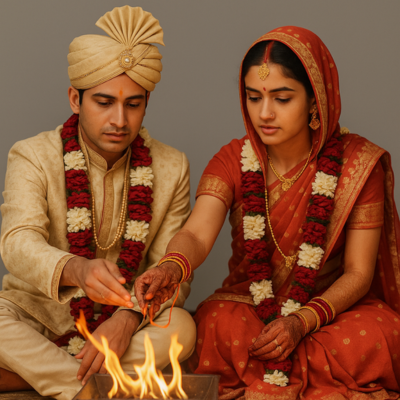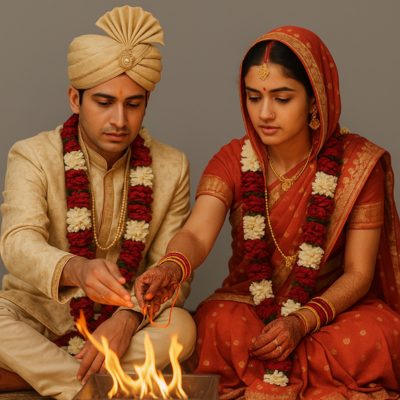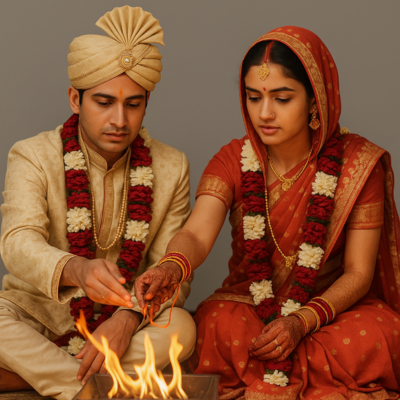Rituals of Arya Samaj Vivah
Step-by-Step Guide to the Marriage Rituals
Every step of Arya Samaj Vivah is rooted in Vedic traditions and carries deep spiritual meaning. Unlike traditional customs where rituals are often performed without explanation, here the Pandit Ji ensures that the couple fully understands the significance of each vow.
The rituals usually include the following:
-
Swagat and Sankalp – The ceremony begins by invoking blessings of the Almighty. The couple declares their pure intention to enter marriage with honesty, love, and mutual respect.
-
Madhuparka Ceremony – The groom is welcomed with a sacred mixture of honey, curd, and ghee, symbolizing purity, sweetness, and prosperity in the new relationship.
-
Kanyadaan – The bride’s parents give their daughter’s hand to the groom, entrusting him with the responsibility to protect, respect, and support her throughout life. Unlike orthodox customs, it emphasizes equality instead of ownership.
-
Havan (Sacred Fire Ritual) – The sacred fire, or Agni, is lit as a divine witness. Offerings are made while Vedic mantras are recited for blessings, purity, and harmony.
-
Pani Grahan (Acceptance of the Bride) – The groom holds the bride’s hand, promising to walk through life together with dignity, faith, and care.
-
Saptapadi (Seven Steps Around the Fire) – The most important ritual, where the couple takes seven sacred steps. Each step represents a lifelong promise: nourishment, strength, wealth, happiness, children, harmony, and eternal friendship.
-
Sindoor and Mangalsutra – Finally, the groom applies sindoor on the bride’s forehead and ties the mangalsutra, signifying the marital bond and lifelong partnership.
महान्त्यपि रिचानि गोऽ जाविध्नधान्यतः। स्त्रीसम्बन्धे दशैतानि कुलानि परिवर्जयेत् ॥ हीनक्रियं निश्पुरुषं निश्छन्दो रोमशार्षसम्। क्षययामायाव्यापस्मारिश्वित्रिकुष्ठिकुलानि च ॥
-मनु0
कितने ही समृद्ध कुल हों, तो भी विवाह-सम्बन्ध में निम्न दश कुलों का त्याग कर दे। वे दस कुल ये हैं-
१. सत्क्रिया से हीन ।
२. सत्पुरुयों से रहित ।
३. वेदाध्ययन से विमुख ।
४. जिस कुल में शरीर पर बड़े-बड़े लोम हों ।
५. जिस कुल में बवासीर हो ।
६. जिस कुल में राजयक्ष्मा हो ।
७. जिस कुल में मन्दाग्रि ।
८. मृगी ।
९. श्वेतकुष्ठ और
१०. गलितकुष्ठ हो ।
ऐसे कुल की कन्ऱ्या के साथ विवाह न करें, क्योंकि ये रोग और दुर्गुण, विवाह करनेवाले के कुल में भी प्रविष्ट हो जाते हैं। परन्तु आज तो विवाह करते समय चमड़ी और दमड़ी देखी जाती है। डारविन महोदय ने ठीक ही लिखा है
-Man sees with scrupulous care the character and pedigree of his horse, cattle and dogs, before he matches them, but when he comes to his own marriage he rarely or never takes such care.
जिस समय मनुष्य अपने घोड़े, पशु और कुत्तों को मिलाता है तब वह उनके गुण, स्वभाव, बल, कद और नस्ल को बड़ी सावधानी से देखता है, परन्तु जब वह अपने विवाह- सम्बन्ध की ओर आता है तब इस ओर कोई ध्यान नहीं देता अथवा बहुत कम ध्यान देता है।
वैदिक धर्म में वर एवं वधू के गुण, कर्म, स्वभाव का मिलान करने पर बड़ा बल दिया गया है। पाश्चात्य डॉक्टर मैगनस हिर्श फील्ड (Dr. Magnus Hirshfield) ने भी इस विषय में बहुत सुन्दर लिखा है-
Happy marriages are not made in heavens butin the laboratory, both the man and woman should be carefully examined not only with regard to their fitness to marry but whether they are fit to marry each other.
विवाह कितने प्रकार का होता है
ब्राह्म, देव, आर्ष, प्रजापत्य, असुर, गान्धर्व, राक्षस और पिशाच ये विवाह आठ प्रकार के होते हैं। ॥
1- ब्राह्म विवाह –
कन्या के योग्य, सुशील, विद्वान् पुरुष का सत्कार कर के कन्या को वस्त्रादि से अलंकृत करके उत्तम पुरुष को बुला अर्थात् जिसको कन्या ने प्रसन्न’ भी किया हो, उसको कन्या देना वह ब्राहा विवाह कहाता है ॥
2- देव विवाह –
विस्तृत यज्ञ में बड़े बड़े विद्वानों का वरण कर उसमें कर्म करने वाले विद्वान् को वस्त्र आभूषण यादि से कन्या को सुशोभित करके देना, वह देव विवाह ॥
3 आर्ष विवाह –
कुछ भी न ले देकर वर एवं कन्या दोनों की पसंद का प्रसन्नता से पाणिग्रहण होना थार्ष विवाह है।
4 -प्राजापत्य विवाह –
कन्या और वर को यज्ञशाला में विधि करके सब के सामने तुम दोनों मिलके गृहाश्रम के कर्मों को यथावत् करो, ऐसा कहकर दोनों को प्रसन्नतापूर्वक पाणिग्रहण होना वह प्राजापत्य विवाह कहाता है।
यह 4 विवाह ही उत्तम विवाह हैं
5 – आसुर विवाह–
वर की जातिवालों और कन्या को यथाशक्ति धन देके, होम आदि विधि कर कन्या देना, आसुर विवाह कहाता
6 गान्धर्व विवाह –
वर और कन्या की इच्छा से दोनों का संयोग होना और अपने मन में मान लेना कि हम दोनों स्त्री-पुरुष है, यह काम से हुआ गान्धर्व विवाह कहाता है ॥
7- राक्षस विवाह-
हनन, छेदन अर्थात् कन्या के रोकने वालों का विदारण कर क्रोशती, रोती, कांपती और भयभीत हुई कन्या को बलात्कार से हरण करके विवाह करना वह राक्षस अति नीच विवाह है ।।
8- पैशाच विवाह-
जो सोती, पागल हुई वा नशा पीकर उन्मत्त हुई कन्या को एकान्त पाकर दूषित कर देना, यह सब विवाहों में नीच से नीच, महानीच, दुष्ट, अति दुष्ट,पैशाच विवाह है ।।१७।।
ब्राह्म, दैव, आर्ष और प्राजापत्य इन ४ (चार) विवाहों में पाणि- ग्रहण किये हुए स्त्री-पुरुषों से जो सन्तान उत्पन्न होते हैं वे वेदादि विद्या से तेजस्वी, आप्त पुरुषों के सम्मत, अत्युत्तम होते हैं ।।
वे पुत्र वा कन्या सुंदर, रूप, बल,पराक्रम, शुद्ध बुद्धयादि उत्तम गुणयुक्त, बहुधनयुक्त, पुण्यकीर्तिमान् और पूर्ण भोग के भोक्ता, अतिशय, धर्मात्मा होकर 100 (सौ) वर्ष तक जीते हैं।॥
इन चार विवाहों से जो शेष रहे 4 विवाह असुर, गंधर्व, राक्षस और पैशाच, इन चार दुष्ट विवाहों से उत्पन्न सन्तान निंदित कर्मकर्ता, मिथ्यावादी, वेदधर्म के द्वेषी, बड़े-बड़े नीच स्वभाव वाले होते हैं
इस लिए मनुष्यों को योग्य है कि जिन निन्दित विवाहों से नीच प्रजा होती हैं उनका त्याग, और जिन उत्तम विवाहों से उत्तम प्रजा होती हैं उनको करना अत्युत्तम है ॥
उत्कृष्टयाभिरूपाय वराय सदृश्य च।
अप्राप्तमपि तां तस्मै कन्यां दद्याद्विचक्षणः ॥ ॥ काममामरणात्तिष्ठेद् गृहे कन्यत्तुर्मत्यषि।
न चैवैनां प्रयच्छेत्तु गुणहीनाय कर्हिचित् ॥ 2॥
त्रीणि वर्षाणयुदीक्षेत कुमायृ- र्तुमति सति
। ऊर्ध्वन्तु कालादेतस्माद्विन्देत सदृशं पतिम् ॥ 3 ॥
[मनु.अ. 9. 88-90]
प्रश्न – विवाह निकटवासियों से अथवा दूरवासियों से करना चाहिए?
उत्तर – दुहिता दुर्हिता दूरे हित भवतिति ॥ (तु.-निरु.3.4 ॥)
यह निरुक्त का प्रमाण है कि जितना दूर देश में विवाह होगा उतना ही उनको अधिक लाभ होगा ।
विवाह संस्कार की मुख्य विधियाँ-
1- स्वागत विधि
2- मधुपर्क विधि
3- गोदान विधि
4- कन्यादानविधि
5- वस्त्र विधि
6- ऋत्विक् वरण विधि संकल्प
7- वैवाहिक यज्ञ विधि
(क)- प्रधान होम
(ख)- राष्ट्रपभृत होम
(ग)- जया होम
(घ)- अभ्यातन होम
(डं)- आष्टाज्याहुति होम
8- पाणिग्रहण विधि
9- लाजा होम
10-ग्रंथि बंधन
11-सप्तपदी
12-सुमंगली एवं यज्ञ समापन विधि
13- आशीर्वाद
सुमङ्गलीरियं वधूरिमां समेत पश्यत।
सौभाग्यमस्यै दत्वायाथास्तं विरेतन,
ऋ.मं.10, सू.85, मं.33: पार.1,8,9॥
उक्त मंत्र को बोल के कार्यार्थ आये हुए लोगों की ओर अवलोकन करना। और इस समय सब लोग-
ओंम् सौभाग्यमस्तु। ओम् शुभं भवतु॥
उक्त वाक्य से आशीर्वाद देवें और वर-वधू पर फूलों की वर्षा करें.


